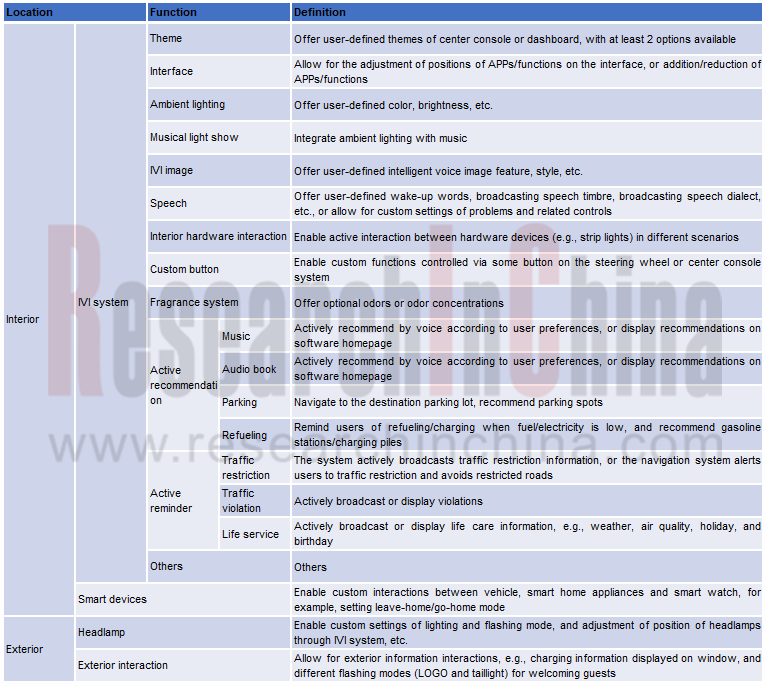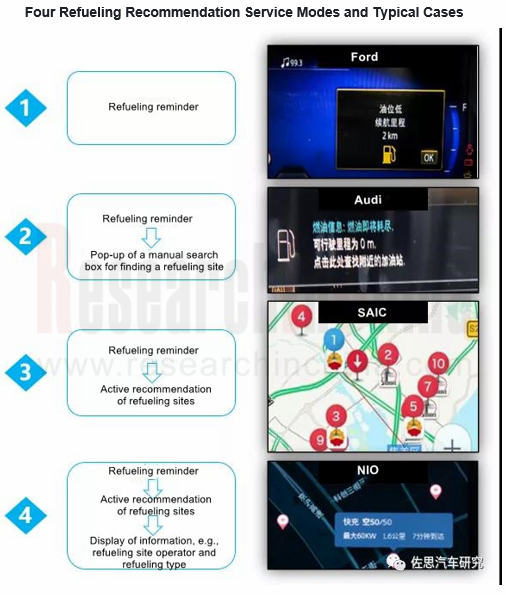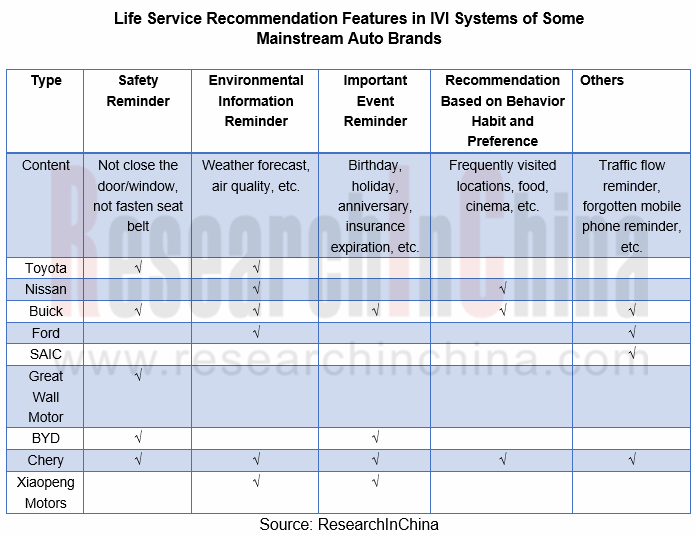Global and China Intelligent Vehicle Personalization Technology Development Report, 2020
Our Global and China Intelligent Vehicle Personalization Technology Development Report, 2020 highlights the analysis and summary of personalization status of mainstream auto brands at home and abroad.

We select, analyze and summarize 19 typical auto brands: Audi, BMW, Mercedes-Benz, Volkswagen, Toyota, Honda, Nissan, Buick, Ford, Geely, SAIC, GAC, Changan Automobile, Great Wall Motor, BYD, Chery, NIO, Xiaopeng Motors, and Weltmeister. The personalized functions we study include: theme (center console display, instrument panel), interface (switching mode, adjustable position of function, addition/reduction of function), ambient lighting (settings of color, brightness, area and mode), musical light show, IVI image (2D/3D switching, optional style), speech (wake-up words, owner's nickname, tone language, language style, AI training, language recognition), interior hardware interaction, custom buttons, fragrance system, active recommendation (music, audio book, parking, refueling), active reminder (traffic restriction, traffic violation, life services), smart devices, custom headlights, and exterior interaction.
This report takes exterior interaction and active recommendation functions as examples to introduce specific personalized functions of an intelligent vehicle.
The wider use of artificial intelligence leads to a shift in IVI service model from passive IVI service instructed by human to active acquisition of information by IVI system and active recommendation to human. In future, the ever deeper fusion of IVI system and third-party service software will come with more mature algorithms and more data accumulated, realizing a service model where more functions can be engaged in an active way.
Music and audio book recommendation
There are currently two leading modes of music and audio book recommendation.
The first is the recommendation feature built in music and audiobook software. Open the software and recommendations will come into sight, a common mode integrated into vehicle software of most auto brands. For example, Kuwo Music for Audi cars offers daily, ranking, Ximalaya FM, and high quality content recommendations; BMW QQ Music recommends daily content and new songs.
The second is the active speech-enabled recommendation according to user habits, preferences or scenarios, which is adopted by Mercedes-Benz, Buick, Ford, Geely, Great Wall Motor and BYD. For instance, Buick judges what users like based on scenarios and their habits, and pushes such as music; Ford IVI system recommends music, radio and point of interest, etc according to user habits; BYD IVI system recommends programs according to what the user often tunes in, sends news during the commuting time, and pushes songs and life programs on weekends and holidays.
Parking recommendation
Parking recommendation refers to recommendation of several nearby parking lots available to the user via a pop-up window from the navigation map in the IVI system before arrival at the destination, for example, SAIC’s IVI navigation system actively recommends 4 parking lots around the destination; Honda’s IVI navigation system enables active pop-up of recommended parking lots when approaching the destination.
Refueling recommendation
Refueling recommendation can be divided into four modes by way to offer services:
1) when fuel/electricity is low, the system gives a refueling reminder;
2) when fuel/electricity is low, the system gives a refueling reminder, with an active pop-up of a manual search box for finding a refueling site;
3) when fuel/electricity is low, the system gives a refueling reminder and automatically recommends refueling sites available to the user;
4) when fuel/electricity is low, the system gives a refueling reminder, automatically recommends refueling sites available to the user, and displays details of the sites, such as operators and refueling types.
In future, the third and fourth modes will prevail.

Life service recommendation and reminder
Life service recommendation and reminder feature is gathering pace, and by content is led by: safety, environment, important event, behavior habit and preference reminders. For example, SAIC’s Banma system actively recommends the route to the cinema as the user starts up the car within two hours before the film begins with tickets bought on Tao Piao Piao platform, and also the playlist or music about the film after the cinema lets out; Alipay applet introduced into Xpeng IVI system will proactively ask whether the user needs a breakfast reservation or not when the car detects he/she will go to work.

Exterior interaction personalization
Exterior information interaction refers to display of such information as vehicle status (e.g., charging), LOGO, welcoming and various prompts using lamps, windows or exterior display devices.
In Xpeng P7’s case, the connection between lamp signal system and audio system enables interior ambient lamps and exterior lighting sets to flicker synchronously with musical rhythms.
Weltmeister interactive window projection: when the user gets close to the car with a phone in hand, he/she will be recognized via Weltmeister ID, and the projector on the inside of the exterior rearview mirror will project welcoming message, remaining battery power, range and other information on the window; when the use gets off the car, others can interact with the car through the projection on the window which displays state of charge for example.
Autonomous Driving Domain Controller and Central Computing Unit (CCU) Industry Report, 2025
Research on Autonomous Driving Domain Controllers: Monthly Penetration Rate Exceeded 30% for the First Time, and 700T+ Ultrahigh-compute Domain Controller Products Are Rapidly Installed in Vehicles
L...
China Automotive Lighting and Ambient Lighting System Research Report, 2025
Automotive Lighting System Research: In 2025H1, Autonomous Driving System (ADS) Marker Lamps Saw an 11-Fold Year-on-Year Growth and the Installation Rate of Automotive LED Lighting Approached 90...
Ecological Domain and Automotive Hardware Expansion Research Report, 2025
ResearchInChina has released the Ecological Domain and Automotive Hardware Expansion Research Report, 2025, which delves into the application of various automotive extended hardware, supplier ecologic...
Automotive Seating Innovation Technology Trend Research Report, 2025
Automotive Seating Research: With Popularization of Comfort Functions, How to Properly "Stack Functions" for Seating?
This report studies the status quo of seating technologies and functions in aspe...
Research Report on Chinese Suppliers’ Overseas Layout of Intelligent Driving, 2025
Research on Overseas Layout of Intelligent Driving: There Are Multiple Challenges in Overseas Layout, and Light-Asset Cooperation with Foreign Suppliers Emerges as the Optimal Solution at Present
20...
High-Voltage Power Supply in New Energy Vehicle (BMS, BDU, Relay, Integrated Battery Box) Research Report, 2025
The high-voltage power supply system is a core component of new energy vehicles. The battery pack serves as the central energy source, with the capacity of power battery affecting the vehicle's range,...
Automotive Radio Frequency System-on-Chip (RF SoC) and Module Research Report, 2025
Automotive RF SoC Research: The Pace of Introducing "Nerve Endings" such as UWB, NTN Satellite Communication, NearLink, and WIFI into Intelligent Vehicles Quickens
RF SoC (Radio Frequency Syst...
Automotive Power Management ICs and Signal Chain Chips Industry Research Report, 2025
Analog chips are used to process continuous analog signals from the natural world, such as light, sound, electricity/magnetism, position/speed/acceleration, and temperature. They are mainly composed o...
Global and China Electronic Rearview Mirror Industry Report, 2025
Based on the installation location, electronic rearview mirrors can be divided into electronic interior rearview mirrors (i.e., streaming media rearview mirrors) and electronic exterior rearview mirro...
Intelligent Cockpit Tier 1 Supplier Research Report, 2025 (Chinese Companies)
Intelligent Cockpit Tier1 Suppliers Research: Emerging AI Cockpit Products Fuel Layout of Full-Scenario Cockpit Ecosystem
This report mainly analyzes the current layout, innovative products, and deve...
Next-generation Central and Zonal Communication Network Topology and Chip Industry Research Report, 2025
The automotive E/E architecture is evolving towards a "central computing + zonal control" architecture, where the central computing platform is responsible for high-computing-power tasks, and zonal co...
Vehicle-road-cloud Integration and C-V2X Industry Research Report, 2025
Vehicle-side C-V2X Application Scenarios: Transition from R16 to R17, Providing a Communication Base for High-level Autonomous Driving, with the C-V2X On-board Explosion Period Approaching
In 2024, t...
Intelligent Cockpit Patent Analysis Report, 2025
Patent Trend: Three Major Directions of Intelligent Cockpits in 2025
This report explores the development trends of cutting-edge intelligent cockpits from the perspective of patents. The research sco...
Smart Car Information Security (Cybersecurity and Data Security) Research Report, 2025
Research on Automotive Information Security: AI Fusion Intelligent Protection and Ecological Collaboration Ensure Cybersecurity and Data Security
At present, what are the security risks faced by inte...
New Energy Vehicle 800-1000V High-Voltage Architecture and Supply Chain Research Report, 2025
Research on 800-1000V Architecture: to be installed in over 7 million vehicles in 2030, marking the arrival of the era of full-domain high voltage and megawatt supercharging.
In 2025, the 800-1000V h...
Foreign Tier 1 ADAS Suppliers Industry Research Report 2025
Research on Overseas Tier 1 ADAS Suppliers: Three Paths for Foreign Enterprises to Transfer to NOA
Foreign Tier 1 ADAS suppliers are obviously lagging behind in the field of NOA.
In 2024, Aptiv (2.6...
VLA Large Model Applications in Automotive and Robotics Research Report, 2025
ResearchInChina releases "VLA Large Model Applications in Automotive and Robotics Research Report, 2025": The report summarizes and analyzes the technical origin, development stages, application cases...
OEMs’ Next-generation In-vehicle Infotainment (IVI) System Trends Report, 2025
ResearchInChina releases the "OEMs’ Next-generation In-vehicle Infotainment (IVI) System Trends Report, 2025", which sorts out iterative development context of mainstream automakers in terms of infota...